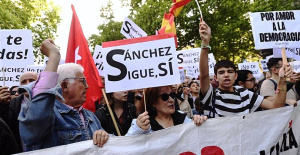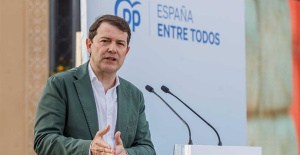MADRID, 12 Ene. (EUROPA PRESS) -
Around 500 employees of the Telefónica group have already voluntarily signed up for the employment regulation files (ERE) that the company will apply in its three main subsidiaries in Spain (Telefónica de España, Móviles and Soluciones) and that will affect 3,421 workers , according to estimates made by union sources to which Europa Press has had access.
The period of affiliation to the collective dismissal began last Tuesday, January 9, and will last until February 8, according to the calendar established by the company and the unions.
In this way, the voluntary secondment would be around 15% in just three working days, explain the sources, who consider that the figure of "more than 500 employees" signed up voluntarily to date is significant, taking into account that many workers They have just returned from vacation and are still evaluating the "singularities" of the ERE.
Furthermore, the sources consulted also point out that it is foreseeable that membership in the ERE will increase in the final stages of the process.
In this context, the stipulated deadlines reflect that the company's response will take place on February 14, while departures will begin mainly on February 29, although the ERE will be open until March 31, 2025.
In the event that voluntary membership in the ERE does not cover the 3,421 planned departures, the company may undertake forced dismissals, while it has also reserved membership limits in areas of activity considered critical.
Contacted by Europa Press, Telefónica has refused to comment on the evolution of membership in the ERE.
As reported by Telefónica to the National Securities Market Commission (CNMV) on January 3, the cost of this collective dismissal is estimated at around 1.3 billion euros (before taxes) and will have no impact on cash.
In this way, the average cost per worker will be around 380,000 euros, a figure lower than the exit plans undertaken by the company in recent years.
Along these lines, Telefónica estimates that the average annual savings of direct expenses will be around 285 million euros from 2025, although the impact on cash generation will be positive from 2024, "as will the capture of savings." , since the departure of employees is estimated to take place as early as the first quarter of 2024.
Specifically, Telefónica has proposed 2,958 departures for Telefónica de España, almost 28% less than the 4,085 that were proposed at the beginning of the negotiations; 397 in Telefónica Móviles, almost 59% less than the initial 958, and 66 in Telefónica Soluciones, almost 19% less than the initial 81.
Therefore, the company has reduced the impact of the collective dismissal by 33% in relation to the 5,124 departures that it proposed to the unions at the beginning of the negotiations.
Telefónica will give employees born in 1968 who leave the ERE an income of 68% of the regulatory salary until age 63 and 38% until age 65, while for those from 1967, 1966, 1965 or 1964, 62% of the regulatory salary until age 63 and 34% until age 65, to which is added a voluntary bonus of 10,000 euros.
Meanwhile, for workers born in 1963 or previous years, it offers an income of 52% of the regulatory salary until age 63 and 34% until age 65, to which it has also added a voluntary bonus of 10,000 euros.
Likewise, the conditions of the ERE include the reversibility of income, which implies that in the event of death the legal heirs will receive the pending compensation.
Also included is the payment of the employee's Social Security discount during unemployment, group insurance up to age 63, and 100% basic health policy up to age 63 (or as long as the Special Social Security Agreement is paid).
In addition, it includes the departure of the 100 employees who were not able to do so in the previous exit plan, among other issues.

 Exploring Cardano: Inner Workings and Advantages of this Cryptocurrency
Exploring Cardano: Inner Workings and Advantages of this Cryptocurrency Seville.- Economy.- Innova.- STSA inaugurates its new painting and sealing hangar in San Pablo, for 18 million
Seville.- Economy.- Innova.- STSA inaugurates its new painting and sealing hangar in San Pablo, for 18 million Innova.- More than 300 volunteers join the Andalucía Compromiso Digital network in one month to facilitate access to ICT
Innova.- More than 300 volunteers join the Andalucía Compromiso Digital network in one month to facilitate access to ICT Innova.-AMP.- Ayesa acquires 51% of Sadiel, which will create new technological engineering products and expand markets
Innova.-AMP.- Ayesa acquires 51% of Sadiel, which will create new technological engineering products and expand markets Abascal (Vox) criticizes that Sánchez is "victimizing" himself and calls for elections after his possible resignation
Abascal (Vox) criticizes that Sánchez is "victimizing" himself and calls for elections after his possible resignation Carlos Alcaraz reaches the round of 16 in Madrid without breaking a sweat
Carlos Alcaraz reaches the round of 16 in Madrid without breaking a sweat Some 5,000 people demonstrate in front of Congress for democracy, hours before Sánchez's decision
Some 5,000 people demonstrate in front of Congress for democracy, hours before Sánchez's decision STATEMENT: Intelligent systems used in the construction of the deepest underwater tunnel in China
STATEMENT: Intelligent systems used in the construction of the deepest underwater tunnel in China How Blockchain in being used to shape the future
How Blockchain in being used to shape the future Not just BTC and ETH: Here Are Some More Interesting Coins Worth Focusing on
Not just BTC and ETH: Here Are Some More Interesting Coins Worth Focusing on UPV students build a prototype of a wooden house to move to Equatorial Guinea
UPV students build a prototype of a wooden house to move to Equatorial Guinea The UA opens the call for the Impulso 2024 Awards for the best innovative business initiatives
The UA opens the call for the Impulso 2024 Awards for the best innovative business initiatives ALI, virtual assistant from Alicante, internationally recognized by the OECD
ALI, virtual assistant from Alicante, internationally recognized by the OECD Retrópolis brings the golden age of video games and computing to the UPV
Retrópolis brings the golden age of video games and computing to the UPV A million people demonstrate in France against Macron's pension reform
A million people demonstrate in France against Macron's pension reform Russia launches several missiles against "critical infrastructure" in the city of Zaporizhia
Russia launches several missiles against "critical infrastructure" in the city of Zaporizhia A "procession" remembers the dead of the Calabria shipwreck as bodies continue to wash up on the shore
A "procession" remembers the dead of the Calabria shipwreck as bodies continue to wash up on the shore Prison sentences handed down for three prominent Hong Kong pro-democracy activists
Prison sentences handed down for three prominent Hong Kong pro-democracy activists ETH continues to leave trading platforms, Ethereum balance on exchanges lowest in 3 years
ETH continues to leave trading platforms, Ethereum balance on exchanges lowest in 3 years Investors invest $450 million in Consensys, Ethereum incubator now valued at $7 billion
Investors invest $450 million in Consensys, Ethereum incubator now valued at $7 billion Alchemy Integrates Ethereum L2 Product Starknet to Enhance Web3 Scalability at a Price 100x Lower Than L1 Fees
Alchemy Integrates Ethereum L2 Product Starknet to Enhance Web3 Scalability at a Price 100x Lower Than L1 Fees Mining Report: Bitcoin's Electricity Consumption Declines by 25% in Q1 2022
Mining Report: Bitcoin's Electricity Consumption Declines by 25% in Q1 2022 Oil-to-Bitcoin Mining Firm Crusoe Energy Systems Raised $505 Million
Oil-to-Bitcoin Mining Firm Crusoe Energy Systems Raised $505 Million Microbt reveals the latest Bitcoin mining rigs -- Machines produce up to 126 TH/s with custom 5nm chip design
Microbt reveals the latest Bitcoin mining rigs -- Machines produce up to 126 TH/s with custom 5nm chip design Bitcoin's Mining Difficulty Hits a Lifetime High, With More Than 90% of BTC Supply Issued
Bitcoin's Mining Difficulty Hits a Lifetime High, With More Than 90% of BTC Supply Issued The Biggest Movers are Near, EOS, and RUNE during Friday's Selloff
The Biggest Movers are Near, EOS, and RUNE during Friday's Selloff Global Markets Spooked by a Hawkish Fed and Covid, Stocks and Crypto Gain After Musk Buys Twitter
Global Markets Spooked by a Hawkish Fed and Covid, Stocks and Crypto Gain After Musk Buys Twitter Bitso to offset carbon emissions from the Trading Platform's ERC20, ETH, and BTC Transactions
Bitso to offset carbon emissions from the Trading Platform's ERC20, ETH, and BTC Transactions Draftkings Announces 2022 College Hoops NFT Selection for March Madness
Draftkings Announces 2022 College Hoops NFT Selection for March Madness























